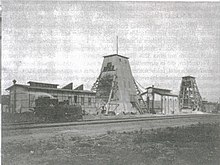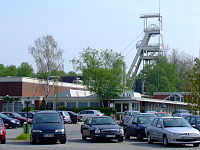Westerholt colliery
| Westerholt colliery | |||
|---|---|---|---|
| General information about the mine | |||
| Westerholt colliery (2009) | |||
| Information about the mining company | |||
| Funded raw materials | |||
| Degradation of | Hard coal | ||
| Geographical location | |||
| Coordinates | 51 ° 36 '4 " N , 7 ° 4' 27" E | ||
|
|||
| Location | Hassel | ||
| local community | Gelsenkirchen | ||
| Independent city ( NUTS3 ) | Gelsenkirchen | ||
| country | State of North Rhine-Westphalia | ||
| Country | Germany | ||
| District | Ruhr area | ||
The Westerholt colliery was the last extracting hard coal mine in Gelsenkirchen-Hassel on the city limits of Herten - Westerholt .
history
1902-1950
The Prussian state acquired at the beginning of the 20th century several large mining field possession in the area of the northern Ruhr area and southern Münsterland. The mining company Recklinghausen was founded, the majority of which was owned by the state. From 1905 onwards, this was headed by Hibernia AG .
In 1902, mine field holdings under Gelsenkirchen-Buer and Westerholt were consolidated to form the Buer coal mine . In 1903, work began on sinking the Bergmannsglück 1/2 double shaft north of Buer .
In 1905 the fiscal minefield properties were divided into mining inspections. The name Berginspektion 3 was assigned to the Buer coal mine . In 1907, on the border from Buer to Westerholt, the sinking of the independent Westerholt 1/2 mining shaft began, as the Prussian state basically wanted to equip every fiscal mine inspection with two mining systems.
The colliery went into operation in 1910 and was equipped with two German strut frames. In 1912 a coking plant was put into operation.
The mine development was very promising economically. As early as 1920 the limit of 1 million t of annual production was exceeded.
In 1925 Mining Inspection 3 was dissolved and it was continued as an independent Westerholt colliery . In 1927, the colliery with the entire property of Bergwerks-AG Recklinghausen became the property of Hibernia AG.
In 1929 the coking plant was expanded because it was to be used for coking coal from Westerholt and Bergmannsglück . Shaft 1 was provided with a new, full-walled headframe with double conveyance.
Towards the end of the 1930s, Hibernia AG began to build an independent conveyor system in the Polsum field, which is adjacent to Westerholt to the north. In 1941 work began on sinking the Polsum 1 shaft in Polsumer Mark, which was intended to be the first production shaft of a double- shaft system to be built.
The ongoing war events brought work to a standstill in 1943. After the Second World War , the Polsum field was connected to the Westerholt colliery. The Polsum 1 shaft was sunk further, but not as a separate conveyor system, but as an external shaft for Westerholt. In 1949 this shaft went into operation.
1950-1998
After the Second World War, Hibernia AG began a comprehensive consolidation and modernization program for the former fiscal mines. In 1952, the new Hassel central coking plant with 160 ovens was built west of the Westerholt 1/2 mine . After it went into operation in 1953, the old Westerholt coking plant was decommissioned and demolished. In 1956, construction of the new central shaft Westerholt 3 began on the old coking plant site. This was equipped with 2 fully automatic rack conveyors . The concrete headframe built in 1960 was an identical sister model of the Shamrock 11 shaft (from 1967 General Blumenthal 11 ).
After its commissioning, the Bergmannsglück 1/2 conveyor system was taken out of service in 1961 and connected to the Westerholt / Polsum mine. Comprehensive rationalization measures temporarily led to annual production of 3.05 million tons. In 1968 the Westerholt colliery was taken over as the Westerholt mine by Ruhrkohle AG . From 1968 to 1970 the Altendorf weather shaft was sunk in the polar area . Due to adaptation measures between 1975 and 1980, the western construction site with the miners' luck shafts was gradually abandoned. In 1982 the Bergmannsglück 1 and 2 shafts were filled . The Polsum field was further opened up by the Polsum 2 weather shaft, which was sunk from 1980 to 1981.
The promotion was carried out exclusively by fully mechanized companies and was at a value of around 2.5 million tons of fat and gas coal per year. The Hassel coking plant produced 600,000 tons of coke annually. Between 1987 and 1991, the Westerholt 1 shaft was deepened to form the central cableway and material shaft . In 1989 a new winding tower was built over it for this purpose.
In 1998 the Westerholt mine was taken over by Deutsche Steinkohle AG (DSK). This closed the mine Westerholt with the mine Fürst Leopold / Wulfen for mine lip together. In the Lippe mine, the Westerholt 1/3, Polsum 1, Polsum 2, Altendorf and Fürst Leopold 1 and 2 shafts were in operation. Westerholt 2 shaft was abandoned and backfilled in 1999, the headframe no longer exists. On December 19, 2008, the Westerholt colliery was shut down when the last wagon of coal was brought to the surface.
Current condition
The Westerholt 1/2/3 mine has been completely preserved to this day, it was named Monument of the Month for June 2010 by the Regional Association of Westphalia-Lippe (LWL) . A planning office was commissioned in September 2008 to create a concept for the future use of the facility. The Polsum 1 shaft and the Polsum 2 and Altendorf weather shafts are also available.
The headframe of the Polsum 1 shaft was acquired in 2010 by SIEMAG TECBERG, which manufactures shaft controls and shaft signaling systems. The heavy steel construction was dismantled and rebuilt in Haiger on the Kalteiche in the immediate vicinity of the A 45 . The shaft structure now serves as a training center and can be seen from afar as a landmark.
literature
- Helmut Madynski: Our Pütt: Westerholt mine. A coal mine of the Ruhrkohle AG in the course of time - on the mining history in the north of Bueren . Bode, Haltern 1994, ISBN 3-925094-60-1 .
Individual evidence
- ↑ There is another winding tower on the cold oak. SIEMAG TECBERG GmbH, October 20, 2010, archived from the original on February 22, 2011 ; accessed on June 10, 2018 .
Web links
- Description of this sight on the route of industrial culture
- Westerholt colliery , on LostAreas.de
- Polsum shaft 1 , on LostAreas.de
- Polsum shaft 2 , on LostAreas.de








